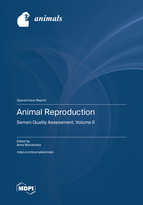Animal Reproduction: Semen Quality Assessment, Volume II
A special issue of Animals (ISSN 2076-2615). This special issue belongs to the section "Animal Reproduction".
Deadline for manuscript submissions: closed (15 November 2024) | Viewed by 36302
Special Issue Editor
Interests: reproduction animals; andrology; spermatozoa; semen quality
Special Issues, Collections and Topics in MDPI journals
Special Issue Information
Dear Colleagues,
I invite you to submit original research papers and review articles to the second edition of the Special Issue “Animal Reproduction: Semen Quality Assessment”.
Semen analysis is an important aspect in the diagnosis of semen used in assisted reproductive technology. Different factors can affect the quality of semen of different animal species. Therefore, a thorough understanding of the mechanisms affecting sperm formation is critical for the proper determination of fertilization capacity. Andrology is constantly introducing new advances in the laboratory evaluation of semen. Growing evidence shows the clinical importance of using specialized tests to assess sperm quality. However, further research is needed to standardize better testing procedures and evaluate the cost-effectiveness of such diagnostic methods. Andrological diagnostics is a continuously developing area of research whose main aim is to assess the reproductive potential of males. The purpose of this Special Issue is to present the latest scientific achievements in the application of modern andrological diagnostics techniques to assess the quality of sperm from various animal species.
Dr. Anna Wysokińska
Guest Editor
Manuscript Submission Information
Manuscripts should be submitted online at www.mdpi.com by registering and logging in to this website. Once you are registered, click here to go to the submission form. Manuscripts can be submitted until the deadline. All submissions that pass pre-check are peer-reviewed. Accepted papers will be published continuously in the journal (as soon as accepted) and will be listed together on the special issue website. Research articles, review articles as well as short communications are invited. For planned papers, a title and short abstract (about 100 words) can be sent to the Editorial Office for announcement on this website.
Submitted manuscripts should not have been published previously, nor be under consideration for publication elsewhere (except conference proceedings papers). All manuscripts are thoroughly refereed through a single-blind peer-review process. A guide for authors and other relevant information for submission of manuscripts is available on the Instructions for Authors page. Animals is an international peer-reviewed open access semimonthly journal published by MDPI.
Please visit the Instructions for Authors page before submitting a manuscript. The Article Processing Charge (APC) for publication in this open access journal is 2400 CHF (Swiss Francs). Submitted papers should be well formatted and use good English. Authors may use MDPI's English editing service prior to publication or during author revisions.
Keywords
- sperm analysis
- semen
- sperm quality
- fertility
- biology of reproduction
- artificial insemination
- andrology
- semen storage
Benefits of Publishing in a Special Issue
- Ease of navigation: Grouping papers by topic helps scholars navigate broad scope journals more efficiently.
- Greater discoverability: Special Issues support the reach and impact of scientific research. Articles in Special Issues are more discoverable and cited more frequently.
- Expansion of research network: Special Issues facilitate connections among authors, fostering scientific collaborations.
- External promotion: Articles in Special Issues are often promoted through the journal's social media, increasing their visibility.
- Reprint: MDPI Books provides the opportunity to republish successful Special Issues in book format, both online and in print.
Further information on MDPI's Special Issue policies can be found here.







